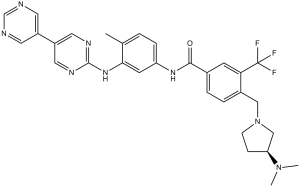This product is for research use only, not for human use. We do not sell to patients.

| Size | Price | Stock |
|---|---|---|
| 250mg | $850 | Check With Us |
| 500mg | $1350 | Check With Us |
| 1g | $2025 | Check With Us |
Cat #: V0679 CAS #: 859212-16-1 Purity ≥ 98%
Description: Bafetinib (formerly INNO406; NS-187), an investigational anticancer drug originally developed by Nippon Shinyaku and later licensed to CytRx, is an orally bioavailable dual Bcr-Abl/Lyn inhibitor with potential antineoplastic activity. It inhibits Bcr-Abl/Lyn with IC50s of 5.8 nM/19 nM in cell-free assays. In Bcr-Abl–positive KU812 mouse model, Bafetinib significantly inhibited tumor growth, and completely inhibited tumor growth without causing adverse effects at a dose of 20 mg/kg/day.
Publications Citing InvivoChem Products
Product Promise

- Physicochemical and Storage Information
- Protocol
- Related Biological Data
- Stock Solution Preparation
- Quality Control Documentation
| Molecular Weight (MW) | 576.62 |
|---|---|
| Molecular Formula | C30H31F3N8O |
| CAS No. | 859212-16-1 |
| Storage | -20℃ for 3 years in powder formr |
| -80℃ for 2 years in solvent | |
| Solubility In Vitro | DMSO: 100 mg/mL (173.4 mM)r |
| Water:<1 mg/mLr | |
| Ethanol: <1 mg/mL | |
| Solubility In Vivo | 0.5% methylcellulose+0.2% Tween 80: 30 mg/mL |
| SMILES Code | O=C(NC1=CC=C(C)C(NC2=NC=CC(C3=CN=CN=C3)=N2)=C1)C4=CC=C(CN5C[C@@H](N(C)C)CC5)C(C(F)(F)F)=C4 |
| Synonyms | INNO-406; INNO 406; NS187; NS187; INNO406;NS-187; NS 187 |
| Protocol | In Vitro | In vitro activity: Bafetinib blocks WT Bcr-Abl autophosphorylation and its downstream kinase activity with IC50 of 11 nM and 22 nM in K562 and 293T cells, respectively. Bafetinib suppresses the growth of the Bcr-Abl-positive cell lines including K562, KU812, and BaF3/wt cells potently without effects on the proliferation of the Bcr-Abl-negative U937 cell line. Moreover, Bafetinib exhibits a dose-dependent antiproliferative effect against Bcr-Abl point mutant cell lines, such as BaF3/E255K cells. In Bcr-Abl+ leukemia cell lines, Bafetinib induces both caspase-mediated and caspase-independent cell death by blocking the phosphorylation of Bcr-Abl. Kinase Assay: Bcr-Abl kinase assays are performed in 25 μL of reaction mixture containing 250 μM peptide substrate, 740 Bq/μL [γ-33P]ATP, and 20 μM cold adenosine triphosphate (ATP) by using the SignaTECT protein tyrosine kinase assay system. Each Bcr-Abl kinase is used at a concentration of 10 nM. Kinase assays for Abl, Src, and Lyn are carried out with an enzyme-linked immunosorbent assay (ELISA) kit. The inhibitory effects of NS-187 against 79 tyrosine kinases are tested with KinaseProfiler. Cell Assay: K562, BaF3/wt, BaF3/E255K, and BaF3/T315I cells are plated at 1 × 103 in 96-well plates, whereas KU812 and U937 cells are plated at 5 × 103in 96-well plates. Cells are incubated with serial dilutions of Bafetinib for 3 days. Cell proliferation is measured by MTT (3-(4,5-dimethylthiazol-2-yl)-2,5-diphenyltetrazolium bromide; Nacalai Tesque) assay, and the 50% inhibitory concentration (IC50) values are calculated by fitting the data to a logistic curve. |
|---|---|---|
| In Vivo | In Bcr-Abl–positive KU812 mouse model, Bafetinib (0.2 mg/kg/day) significantly inhibits tumor growth, and completely inhibits tumor growth without adverse effects at 20 mg/kg/day. For Balb/c mice, Bafetinib shows maximal tolerated dose of 200 mg/kg/d and bioavailability value (BA) of 32%. In a Central nervous system (CNS) leukemia model bearing Ba/F3/wt bcr-ablGFP, Ba/F3/Q252H, or Ba/F3/M351T cells, combination treatment of Bafetinib (60 mg/kg) and cyclosporine A (CsA) (50 mg/kg) leads to more significant inhibition of leukemia growth in the brain than either Bafetinib or CsA alone. | |
| Animal model | KU812 xenograft is established by subcutaneous injection of KU812 cells into the right flank of Balb/c-nu/nu female mice. | |
| Formulation | Bafetinib is dissolved in 0.5% methylcellulose; | |
| Dosages | ≤20 mg/kg/day; p.o. |
| Solvent volume to be added | Mass (the weight of a compound) | |||
|---|---|---|---|---|
| Mother liquor concentration | 1mg | 5mg | 10mg | 20mg |
| 1mM | 1.7342 mL | 8.6712 mL | 17.3424 mL | 34.6849 mL |
| 5mM | 0.3468 mL | 1.7342 mL | 3.4685 mL | 6.9370 mL |
| 10mM | 0.1734 mL | 0.8671 mL | 1.7342 mL | 3.4685 mL |
| 20mM | 0.0867 mL | 0.4336 mL | 0.8671 mL | 1.7342 mL |
This equation is commonly abbreviated as: C1 V1 = C2 V2
- (1) Please be sure that the solution is clear before the addition of next solvent. Dissolution methods like vortex, ultrasound or warming and heat may be used to aid dissolving.
- (2) Be sure to add the solvent(s) in order.




































